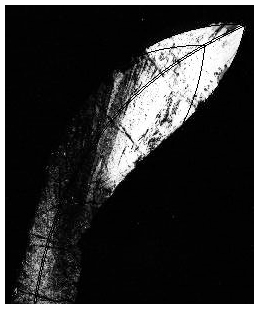
Does crystal splitting play a part in the curvature of helictites?
- George W. Moore
-
- Journal of Cave and Karst Studies, v. 62, p. 37 (2000).
-
- At straight segments of calcite helictites, the crystal
axis of fastest growth maintains a constant orientation, whereas at curved
segments it follows the curvature. Three mechanisms for rotated crystals
are (1) the long axes of the crystals in conical stalactites always point
toward their curved outer surface, because they crowd out slower growing
seed crystals of other orientations; (2) Russian investigators explain
radiating crystals by crystal splitting, the insertion of molecular wedges
to divide an initial crystal; and (3) microorganisms cause a nontypical
diagonal orientation of calcite moonmilk grains. Helictites are nourished
by a capillary at the tip. The growth increments consist of nested cones,
but thin sections show that the crystal units are wedges that diagonally
cross the whole helictite. The youngest wedge points toward the intersection
between two faces of the helictite's 3-sided pyramidal tip. The wedges
grow toward that intersection (the trace of a scalenohedral tip) and by
crystal overgrowth at the edges of older wedges. Deposition follows the
crystal lattice of the wedges but is greatest near the capillary, leading
to an increased angle. When water flow stops periodically, subsequent growth
is controlled by crystal crowding. It is perpendicular to the outside of
the curve next to the capillary, and its crystal orientation differs slightly
from that of the previous wedge. We cannot with certainty distinguish crystal
crowding from crystal splitting near the orifice of the capillary, but
crystal splitting ought to cause fanning from the orifice, whereas the
wedges are planar across the entire helictite.